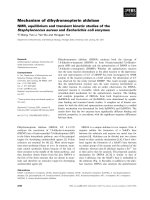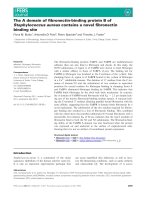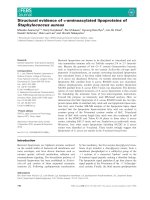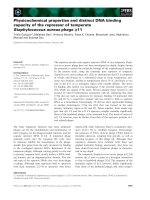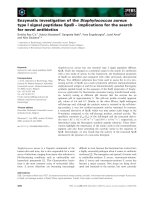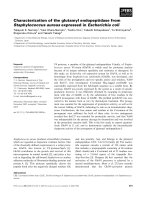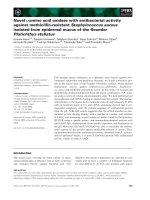Outcomes of staphylococcus aureus bacteremia
Bạn đang xem bản rút gọn của tài liệu. Xem và tải ngay bản đầy đủ của tài liệu tại đây (1.08 MB, 153 trang )
OUTCOMES OF STAPHYLOCOCCUS AUREUS BACTEREMIA
PRABHA PARTHASARATHY
(M.D MICROBIOLOGY, INDIA)
A THESIS SUBMITTED FOR THE
DEGREE OF MASTER OF SCIENCE
DEPARTMENT OF MEDICINE
NATIONAL UNIVERSITY OF SINGAPORE 2009
i
ACKNOWLEDGEMENTS
I wish to express my deepest gratitude and sincere thanks to my supervisor Associate
Professor Paul Anantharajah Tambyah, Division of Infectious Disease, Department of
Medicine for his profound interest, support and guidance throughout the period of my
graduate stay at the National University of Singapore. I am also thankful to him
providing me with the necessary funds to perform the laboratory work and for critically
reviewing this thesis.
I would also like to express my gratitude to the entire staff of the Division of Infectious
Disease including the consultants and the registrars. I am grateful to Dr. Hsu Li Yang for
providing guidance in molecular typing and Dr. Dale Fisher, Dr. Arlene Chua and Dr.
Sophia Archuleta for reviewing the patients in the trial and providing timely feedback.
I would also like to express my thanks to the Department of Microbiology, to Dr.
Raymond Lin for his advise and support in regards to the molecular typing and Dr.
Roland Jureen for helping me with the analysis of Spa typing results. I appreciate the
help provided by the staff of Microbiology at different stages, Donald Chiang for
providing me the Staphylococcus aureus strains, Leela and Zarinah for informing me
about new cases and to Carol, Technical Head. I am deeply grateful to Dr. Jeanette Teo,
postdoctoral fellow at the Department of Microbiology for helping me set up the
molecular diagnostic facility.
I would also like to thank the Research Division of Infectious Disease, especially Dr.
Anupama Vasudevan, Clinical Research Coordinator, for helping me with the statistical
analysis and providing support for IT related issues. I would like to thank M.B.B.S
students Dr. Jonathan Chia and Dr. Raji for helping me collect the data.
I owe a special thanks to the staff at the National University Hospital who cooperated a
great deal for this study in spite of having a hectic and demanding schedule. And last and
not the least, this study would have not been possible without the cooperation of the
patients and the physicians. I hope the results of this study would translate to a better care
and outcome for these patients.
My work would be incomplete without the help of my family, who have sacrificed a great
deal during my study.
Finally, I am glad that The National University of Singapore provided me this
opportunity and awarded me with the research scholarship to make this study happen.
ii
TABLE OF CONTENTS
ACKNOWLEDGEMENTS.................................................................................................................... I
TABLE OF CONTENTS....................................................................................................................... II
LIST OF FIGURES AND TABLES...................................................................................................... V
SUMMARY ..........................................................................................................................................VI
LIST OF ABBREVIATIONS ............................................................................................................VIII
CHAPTER 1 ........................................................................................................................................... 1
REVIEW OF LITERATURE................................................................................................................. 1
1.1
INTRODUCTION..................................................................................................................... 1
1.2
EPIDEMIOLOGY OF SAB...................................................................................................... 3
1.2.1
1.2.2
1.2.3
1.2.4
INCIDENCE .............................................................................................................................. 3
MODE OF ACQUISITION ............................................................................................................ 4
PROBLEM OF MRSA BACTEREMIA ........................................................................................... 5
THE ASIAN SCENARIO ............................................................................................................. 6
1.3
RISK FACTORS....................................................................................................................... 8
1.4
PATHOPHYSIOLOGY AND CLINICAL MANIFESTATIONS ......................................... 11
1.5
COMPLICATIONS AND OUTCOME .................................................................................. 13
1.5.1
1.5.2
1.5.3
PROGNOSIS ........................................................................................................................... 13
ENDOCARDITIS:..................................................................................................................... 14
OTHER COMPLICATIONS AND RECURRENCE ............................................................................ 16
1.6
METHICILLIN RESISTANT STAPHYLOCOCCUS AUREUS AND OUTCOMES....... 17
1.7
REDUCED SUSCEPTIBILITY TO VANCOMYCIN AND OUTCOMES........................... 18
1.8
INFECTIOUS DISEASE (ID) CONSULTATION ON OUTCOMES ................................... 22
1.9
ANTIBIOTIC THERAPY AND OUTCOMES ...................................................................... 23
1.9.1
1.9.2
1.9.3
1.9.4
1.9.5
1.10
1.11
1.11.1
1.11.2
1.12
DRUG OF CHOICE ................................................................................................................... 24
DOSAGE ................................................................................................................................ 24
ROUTE OF ADMINISTRATION .................................................................................................. 25
DURATION OF THERAPY ......................................................................................................... 25
OPTIMAL ANTIBIOTICS AND OUTCOMES .................................................................................. 26
REMOVAL OF SOURCE AND OUTCOMES...................................................................... 27
GENETIC ANALYSIS OF STAPHYLOCOCCUS AUREUS BACTEREMIA ...................... 28
BACKGROUND ...................................................................................................................... 28
GENOTYPING OF MRSA AND STAPHYLOCOCCUS AUREUS BACTEREMIA .................................. 29
AIMS OF THE STUDY .......................................................................................................... 33
CHAPTER 2 ......................................................................................................................................... 34
MATERIALS AND METHODS .......................................................................................................... 34
2.1 EPIDEMIOLOGICAL METHODS ............................................................................................... 34
2.1.1
2.1.2
2.1.3
SUBJECTS FOR INCLUSION INTO THE STUDY ............................................................................ 34
SUBJECTS FOR INCLUSION IN THE CLINICAL TRIAL ................................................................... 34
TRIAL WORKFLOW ................................................................................................................ 35
iii
2.1.4
2.1.5
2.1.6
2.1.7
CHART REVIEW ..................................................................................................................... 37
OUTCOME MEASURES ............................................................................................................ 37
STATISTICAL ANALYSIS ......................................................................................................... 40
MICROBIOLOGICAL METHODS ................................................................................................ 41
2.2 LABORATORY METHODS.......................................................................................................... 42
2.2.1
2.2.2
2.2.3
2.2.4
2.2.5
DNA EXTRACTION ................................................................................................................ 42
PRIMER PREPARATION ........................................................................................................... 42
PCR PROTOCOL .................................................................................................................... 43
PURIFICATION OF PCR PRODUCTS .......................................................................................... 44
DNA SEQUENCING AND ANALYSIS ......................................................................................... 44
CHAPTER 3 ......................................................................................................................................... 45
RESULTS 1: EPIDEMIOLOGY AND OUTCOMES OF SAB AT A TERTIARY CARE CENTRE
IN SINGAPORE................................................................................................................................... 45
3.1
OVERVIEW............................................................................................................................ 45
3.2
AGE AND SEX DISTRIBUTION .......................................................................................... 45
3.3
DISTRIBUTION IN DIFFERENT DISCIPLINES................................................................ 46
3.4
MODE OF ACQUISITION .................................................................................................... 47
3.5
MRSA PROFILE .................................................................................................................... 49
3.6
RISK FACTORS..................................................................................................................... 50
3.7
PORTAL OF ENTRY (SOURCE OF BACTEREMIA) ........................................................ 51
3.8
OUTCOME AT A GLANCE.................................................................................................. 51
3.9
MORTALITY PROFILE ....................................................................................................... 52
3.10
METASTATIC INFECTIONS............................................................................................... 57
3.11
RECURRENCE ...................................................................................................................... 59
3.12
OUTCOMES AND PREDICTORS OF MRSA BACTEREMIA........................................... 62
3.13
OUTCOMES OF HIGHER VANCOMYCIN MIC AMONG MRSA ISOLATES................ 62
3.14
OUTCOMES DEPENDING ON THE STANDARD OF CARE............................................ 68
3.14.1
3.14.2
3.14.3
3.14.4
3.14.5
ID CONSULTATION DETAILS .............................................................................................. 68
ANTIBIOTIC DETAILS ......................................................................................................... 69
REMOVAL OF LINE SOURCE ............................................................................................... 69
ECHOCARDIOGRAPHY ....................................................................................................... 70
FOLLOW UP BLOOD CULTURES ........................................................................................... 70
CHAPTER 4 ......................................................................................................................................... 72
RESULTS 2: A RANDOMISED CONTROL TRIAL OF ID CONSULT IN SAB ............................. 72
4.1
PER-PROTOCOL ANALYSIS .............................................................................................. 74
4.2
INTENTION TO TREAT ANALYSIS................................................................................... 74
4.3
PERTREATMENT ANALYSIS............................................................................................. 75
CHAPTER 5 ......................................................................................................................................... 82
RESULTS 3: MOLECULAR EPIDEMIOLOGY OF SAB IN A TERTIARY CARE HOSPITAL ... 82
CHAPTER 6 ......................................................................................................................................... 87
DISCUSSION ....................................................................................................................................... 87
iv
6.1
EPIDEMIOLOGY .................................................................................................................. 88
6.2
MORTALITY ......................................................................................................................... 91
6.3
METASTATIC INFECTION AND RECURRENCE ............................................................ 97
6.4
INFECTIOUS DISEASE CONSULTATION....................................................................... 101
6.5
PROBLEM OF HIGH VANCOMYCIN MIC AND RECOGNITION................................ 102
6.6
GENOTYPING ..................................................................................................................... 103
6.7
LIMITATIONS..................................................................................................................... 106
6.8
CONCLUSIONS ................................................................................................................... 107
v
LIST OF FIGURES AND TABLES
Figure 1 Trial workflow.............................................................................................36
Figure 2 HP POCKET PC with a sample of the HanDBase® database.......................38
Figure 3: Monthly distribution of SAB cases ..............................................................45
Figure 4: Age and sex distribution of Staphylococcus aureus bacteremia ....................46
Figure 5: Mode of acquisition of Staphylococcus aureus bacteremia ...........................49
Figure 6: Timing of nosocomial infection ...................................................................49
Figure 7: Antimicrobial resistance profile of MRSA ...................................................50
Figure 8: Vancomycin MIC distribution among MRSA (n=126) .................................50
Figure 9: Time from onset of bacteremia to death .......................................................53
Figure 10: Age, APACHE Score, Charlson index for patients who died versus survivors
..............................................................................................................................54
Figure 11: Metastatic infections in Staphylococcus aureus bacteremia (n=260)............57
Figure 12: Breakdown of the metastatic infection sites.................................................58
Figure 13: Metastatic infections in MRSA/MSSA bacteremia......................................58
Figure 14: Antibiotic characteristics.............................................................................71
Figure 15: Details of randomised controlled trial ........................................................73
Figure 16: Clustering of MRSA and MSSA .................................................................84
Figure 17: Worldwide proportions of Staphylococcus infections due to MRSA ...........90
Table 1 Breakpoints for vancomycin susceptibility/resistance* ......................................20
Table 2 Overview of the major clones of methicillin-resistant Staphylococcus aureus
(MRSA).................................................................................................................31
Table 3 CASE DEFINTIONS........................................................................................39
Table 4 Primers used for PCR........................................................................................42
Table 5 Master mix for PCR reaction.............................................................................43
Table 6 Thermocycling conditions used for the PCR reaction ........................................43
Table 7 Distribution in different disciplines ...................................................................47
Table 8 Analysis of predictors of all cause in hospital mortality.....................................55
Table 9 Analysis of predictors of metastatic infections...................................................60
Table 10 Predictors of mortality of MRSA bacteremia...................................................63
Table 11 Predictors and outcomes of a high vancomycin MIC value..............................66
Table 12 Perprotocol Analysis .......................................................................................76
Table 13 Intention to treat analysis ................................................................................78
Table 14 Pertreatment analysis ......................................................................................80
Table 15 Spa types in MRSA and MSSA isolates ..........................................................82
Table 16 Antimicrobial profile of MRSA spa types .......................................................83
Table 17 Comparison of patient characteristics and outcomes of spa type t032 and t037
MRSA bacteremia..................................................................................................85
Table 18 Incidence of MRSA infections in acute care hospitals per 1000 discharges and
deaths (Adapted from MOH occasional paper 2007/23) .........................................89
vi
SUMMARY
Staphylococcus aureus bacteremia (SAB), a leading cause of community and healthcare
associated bacteremias is well known for complications such as a high mortality rate,
endocarditis, metastatic infections and recurrence. The epidemiology of SAB is different
worldwide due to differing rate of Methicillin Resistant Staphylococcus aureus (MRSA)
and different comorbidities in the population. While most of the reports are available
from the Western World, there is scant information in the Asian context. Hence, we
decided to undertake this study at the National University Hospital with the main aim to
define the outcomes of SAB. In addition, we evaluated the effect of an Infectious Disease
(ID) consultation in a randomized trial and performed genotyping by the Staphylococcus
Protein A (Spa) Typing method on a subset of strains. We recruited 300 consecutive
patients with SAB making this one of the largest cohorts of SAB patients to be studies in
Asia. .
The SAB and MRSA bacteremia rate was 3.42 and 1.44 per 1000 discharges or deaths.
The epidemiology was characterized by a high percentage of MRSA (42%) and
underlying comorbidities(88.4%). The mortality, infective endocarditis and recurrence
rate was 29, 14.5% and 9.9% of all SAB cases respectively. On a multivariate logistic
regression, MRSA infection, elderly age, malignancies, history of skin disease, and a
higher APACHE score were associated with mortality; persistent bacteremia and IV drug
use was associated with metastatic infections. In MRSA patients, metastatic seeding was
commonly isolated bony infection and infective endocarditis. 21% of the MRSA strains
had a vancomycin MIC of 2 or higher. The higher MIC was associated with bony
metastatic infection and persistent bacteremia.
vii
An ID consultation when evaluated in a randomized trial was associated with a better
standard of care; however, outcomes of mortality and recurrence were comparable. The
results are still preliminary and further evaluation of other outcome parameters is needed
before drawing conclusions.
Genotyping of MRSA revealed 9 Spa types, 89% of which belonged to t032 (ST22, EMRSA15, 21%) and t037 (ST 239-241, 68%). There was only one case of C-MRSA. Spa
type t032 was associated with more endocarditis and pneumonia, however, mortality and
recurrence was similar to t037.
In conclusion, the epidemiology and outcomes at our center were similar to those
reported from the Western World such as USA or UK. The high proportion of infections
due to MRSA warrants an intensification of the current infection control practices. There
is a need for use of scoring systems such as APACHE II And Charlson score to adjust for
underlying comorbidities. SAB patients including MRSA cases are prone for metastatic
infections; hence a high degree of suspicion and imaging, in particular Transesophageal
echocardiography is warranted. Amidst concerns of rising rates of the emergent E-MRSA
15 (t032), the outcome of bacteremia due to this clone was not different from others. Spa
typing is a convenient and a good screening molecular typing method to draw relevant
epidemiological conclusions.
viii
LIST OF ABBREVIATIONS
SAB
Staphylococcus aureus bacteremia
CDC
Center of Disease Control and Prevention, USA
CLSI
Clinical and Laboratory Standards Institute
C-MRSA
Community acquired Methicillin Resistant
Staphylococcus aureus
COPD
Chronic Obstructive Pulmonary Disease
CRP
C-Reactive Protein
CVC
Central Venous catheter
CVS
Cardiovascular disease
E-MRSA
Epidemic-Methicillin Resistant Staphylococcus aureus
HIV
Human Immunodeficiency Virus
H-MRSA
Healthcare acquired Methicillin Resistant Staphylococcus
aureus
hVISA
Hetero VISA
ICU
Intensive care unit
ID
Infectious Disease
IE
Infective endocarditis
IQR
InterQuartile Range
IV
Intravenous
IVDU
Intravenous drug use
ix
LOS
Length of stay
MLST
Multilocus sequence typing
MRSA
Methicillin-Resistant Staphylococcus aureus
MSSA
Methicillin Sensitive Staphylococcus aureus
OR
Odds ratio
PFGE
Pulse Field Gel Electrophoresis
PFTE
Polytetrafluoroethylene grafts
Spa
Staphylococcal Protein A
SSI
Skin/soft tissue infections
TEE
Transesophageal echocardiography
TTE
Transthoracic echocardiography
US
United States
USA
United States of America
VISA
Vancomycin Intermediate Staphylococcus aureus
VRSA
Vancomycin Resistant Staphylococcus aureus
PVL
Panton Valentine Leucocidin
AV
Arteriovenous
DIC
Disseminated intravascular coagulation
MIC
Minimum inhibitory concentration
H/O
History of
CHAPTER 1
REVIEW OF LITERATURE
1
1.1 INTRODUCTION
Staphylococcus aureus, the causative organism of Staphylococcus aureus bacteremia
(SAB) are Gram-positive cocci that are arranged in clusters as seen on a gram stain. This
bacterium is extremely hardy and can survive on dried clinical material for months. It is
also easily transmissible from person to person. The bacterium grows on common culture
media including nutrient agar and sheep blood agar. Its ability to grow in a high
concentration of salt and ferment mannitol has been utilized to develop selective media
such as Mannitol Salt Agar.
Staphylococcus aureus can be differentiated from other members of this genus such as
S.epidermidis and S.saprophyticus by its appearance on blood agar plates and additional
biochemical tests(1). The characteristic colonies of Staphylococcus aureus are round, 12mm, golden yellow in colour with a zone of complete hemolysis on sheep or horse
blood agar. In addition, Staphylococcus aureus gives a positive coagulase test, ferments
mannitol, is sensitive to novobiocin and produces DNAase.
Staphylococcus aureus is among one of the most pathogenic members in its genus. It is
armed with a range of surface proteins, enzymes and toxins that can lead to an
inflammatory reaction at the local site and in some instances a toxin mediated effects at a
distant site. Infections due to Staphylococcus aureus are broadly categorized as pyogenic
or toxin mediated disease. Among the pyogenic infections, skin infections such as
impetigo, carbuncles, furuncles, cellullitis and blephritis are common. At times, the
bacteria can seed the blood and cause bacteremias and endocarditis. The other pyogenic
infections include osteomyelitis, post surgical wound infections and pneumonias. Toxin
2
mediated diseases include food poisoning due to enterotoxins, toxic shock syndrome and
scalded skin syndrome.
Common antibiotics used in the treatment for Staphylococcus aureus include methicillin,
cloxacillin, cefazolin, levofloxacin, cotrimoxazole and vancomycin. The therapy is
largely directed by the antimicrobial susceptibility profile of the organism. Penicillin, a
beta-lactam antibiotic, the first to be used for Staphylococcus aureus is no longer in
common usage as almost 90% of the strains are resistant to it. Methicillin resistance in
Staphylococcus aureus (MRSA) was first documented in 1961 and since then there has
been a growing concern for various reasons. Firstly, MRSA strains are resistant to other
classes of antibiotics, thus limiting the therapeutic options to few select agents such as
vancomycin, daptomycin and linezolid. Secondly, MRSA is particularly notorious in
hospital environments, commonly seen in patients with serious underlying comorbidities
and those undergoing invasive diagnostic or therapeutic procedures during the hospital
stay. Outcomes in these patients are poor with a high mortality rate and increased hospital
costs and length of stay among the survivors.
Thirdly, MRSA, although mainly a
healthcare associated issue, seems to be increasingly recognized in the community
causing infections among healthy young adults who have not had any contact with
healthcare facilities previously. Finally, many countries have witnessed a dramatic rise in
the number of Staphylococcal infections attributable to MRSA. In some countries this
percentage is as high as 40%(2). Due to the nature of the problem, many healthcare
institutes across the world have implemented active surveillance programs to curtail the
spread. Some of the common measures include screening, isolation and eradication of
carriage especially in high-risk patients.
3
Staphylococcus aureus bacteremia or SAB although rare, is one of the dreaded
complications of Staphyloccoccus aureus infection. In addition to a high mortality rate
anywhere between 20-30% of all cases. (3-7), SAB is also associated with complications
such as endocarditis, metastatic seeding and recurrences. The epidemiology and
outcomes of SAB vary in different countries and largely depend on the prevalence of
MRSA and underlying risk factors. Although well recognized in the Western World (3,
7-10), there is a paucity of data from the Asian continent. Hence, this study was
conducted to understand the epidemiology and outcomes of Staphylococcus aureus
bacteremia in Singapore.
1.2 EPIDEMIOLOGY OF SAB
1.2.1 Incidence
Staphylococcus aureus is a leading cause of community and hospital acquired
bacteremias. It is the second most important cause of Nosocomial and Community
acquired bacteremias after Coagulase Negative Staphylococcus and Escherichia coli
respectively(11, 12). In a retrospective review across 17 hospitals in Australia, 25% of all
bacteremias were attributed to Staphylococcus aureus(10) .
Most of the Staphylococcus aureus bacteremia (SAB) data are available from Europe and
North America. Over the previous two decades, many of these countries have recorded a
marked increase in the incidence of Staphylococcus aureus infections.
Finland noticed
an increase from 11 per 100,000 in 1995 to 17 per 100,000 in 2001 (p value <0.001)(3)
.In Denmark, on an average, there has been a 5.3% annual increase in Staphylococcus
aureus bacteremia incidence rate from 1981 to 2000(4).
4
In a population-based study conducted in Calgary, Canada, the average incidence rate of
Staphylococcus aureus bacteremia was estimated at 19.7 cases/100,000 population with
no significant change from 2000-2006. However, during the same period the rate of
MRSA bacteremia increased dramatically (p<0.001)(5). The National Nosocomial
Infections Surveillance reported a rise in nosocomially acquired Staphylococcus aureus
bacteremia in the US from 1980 to 1989 (p value <0.001)(13). Many countries have
witnessed such a rise in specific subpopulations of SAB.
1.2.2 Mode of acquisition
Till late, SAB was commonly defined as “nosocomial” or “community acquired”
according to the US Center of Disease Control and Prevention (CDC) definitions(14).
This was based on the timing of the positive blood culture. A positive Staphylococcus
aureus blood culture drawn in the first 48 hours of hospitalization from a patient was
assumed to be a community acquired bacteremia while a positive blood culture after 48
hours of hospitalization is believed to be nosocomially acquired. Many authors and
clinicians now feel the need to define a third category, namely Healthcare associated
infection (8, 15-17). This category includes all those SAB episodes labeled as
“community acquired” in patients with specific healthcare risk factors. The SAB
infection in these patients was thought to be related to their healthcare exposure rather
than a community acquired bacteremia. The need for this category arose with increasing
number of patients seeking healthcare outside the hospital in particular, home dialysis
and intravenous (IV) home therapy. Currently, there is no consensus on the definition of
previous healthcare exposure. In a recent paper, Klevens and Colleagues used the
following criteria(8).
5
•
IV home therapy
•
History of MRSA colonization
•
History of surgery, hospitalization, dialysis or residence in a long term facility in
the last one year
It appears that almost 2/3rds of all Staphylococcus aureus bacteremias are in patients
with previous or ongoing healthcare exposure. In a retrospective review of SAB cases
across 17 hospitals in Australia(10) , 51% were nosocomial, 34% community onset and
15%
healthcare associated. In another population based surveillance conducted in
Calgary, Canada from 2000-2006(5), 1542 bacteremic cases were reported with 39%
nosocomial , 25% community onset and 36% healthcare associated infections.
The impact of various modes of acquisition on the outcome is described elsewhere.
1.2.3 Problem of MRSA bacteremia
The proportion of Staphylococcus aureus bacteremias caused by MRSA varies in
different countries. It is documented to be as high as 40% in United Kingdom(2) to as
low as 1% in the Scandinavian countries of Denmark and Sweden(4) . Most of the
MRSA bacteremias (70-85%) are healthcare related (8, 10).
In recent years, there have been concerns about an increasing number of MRSA causing
community onset infections. Genotypically, strains of MRSA causing community onset
infections (C-MRSA) are known to be different from their hospital counterparts (HMRSA). Although many infections are self-limiting, the infection can be severe at times
and lead to bacteremias. Community MRSA bacteremia is usually seen in the younger
patients with no serious comorbidities unlike healthcare associated MRSA which is seen
in older patients with significant comorbidities(18).
6
The global extent of the problem of C-MRSA is not fully known. Nevertheless, many
countries seem to be recognizing the problem. In certain countries, 15-30% of the
community-acquired bacteremias are caused by C-MRSA(6, 19). A 10-year (1997-2007)
retrospective review of SAB cases presenting at a tertiary care center in Perth, Australia
revealed that almost 10% of all the MRSA bacteremic cases could be attributed to CMRSA. Similar rates (12%) have been reported from the US(8). Among the Perth cohort,
Intravenous Drug usage (IVDU) was the only risk factor associated with C-MRSA and
the 7-day and 30-day mortality did not vary significantly between H-MRSA and CMRSA bacteremia in this cohort (18) .
In Singapore, the problem of C-MRSA also seems to be increasingly recognized as well.
At a tertiary care center, a search through the microbiology archives from 2001-2004
yielded only 8 possible C-MRSA cases, however, between May 2004 to June 2005, there
were a further 37 isolates. All these cases appear to be imported through construction
workers or maids and the mean age of these patients was 35 years. Although most of the
cases (35 of 42) were cutaneous abscesses, there was one case of C-MRSA bacteremia in
2004 in a patient with IVDU(20). A genetic analysis of C-MRSA strains by Hsu and
colleagues showed that majority of the community MRSA strains isolated from 20002005 showed the presence of Panton Valentine Leucocidin (PVL) toxin and belonged to
multilocus type ST30 (21).
1.2.4 The Asian Scenario
Most reports from Asia come from experiences at tertiary care centers. Although these
reports cannot be extrapolated to the general population, they seem to suggest a dynamic
7
epidemiology as seen in the other parts of the world. Highlighted below are the
experiences from two countries, Taiwan and Singapore.
1. The Taiwan Experience:
MRSA accounted for 53% to 83% of all Staphylococcus aureus clinical isolates in
12 major hospitals in 2000(22) .
Proportion of infections attributed to MRSA has increased dramatically over the last
decade or two. At a university hospital, this proportion was 39% in 1991 and 75% in
2003(23).
The prevalence of C-MRSA has also increased over years. A study from one of the
centers reported a rate of 32% per year from 2001 to 2006(24).
As mentioned earlier, high proportions (30%) of community acquired SAB are
MRSA(19) .
2. The Singapore Experience:
At the National University Hospital, Singapore, a total of 100 patients presented with
MSSA bacteremia within the first 48 hours of hospitalization between March 2005 to
February 2006. Forty eight percent of these patients had previous healthcare
exposure(25).
Approximately 35% of all Staphylococcus aureus isolates are methicillin resistant
(MRSA)(26).
There are suggestions of an increasing number of C-MRSA isolates in hospitals. The
experience of Singapore General Hospital is mentioned earlier(20) .
8
1.3 RISK FACTORS
SAB is frequently seen in the following group of patients(27)
•
Elderly patients
•
Patients
with
Cardiovascular
underlying
disease
comorbidities
(CVS),
Human
including
Diabetes
Immunodeficiency
mellitus,
virus(HIV),
Carcinoma, Rheumatoid arthritis and rare blood disorders such as Job’s
syndrome, Chediak-Hegashi syndrome etc.
•
Hemodialysis, peritoneal dialysis, and other hospital related invasive procedures
•
Presence of a foreign body in particular, orthopedic devices, prosthetic heart
valves and urinary catheters.
•
Intravenous drug abusers
•
Surgical site infection
•
Patients residing in long term care facilities (including nursing homes)
The risk factors for SAB vary depending on the mode of acquisition. Patients with
community-acquired infections tend to be younger and less likely to have comorbidities
than nosocomial or healthcare associated infection.
Community acquired SAB is
commonly seen in IVDU’s and the underlying source of infection is not usually clear(27).
Patients with nosocomial SAB tend to be older and frequently have the above mentioned
comorbid conditions. Intravascular catheterisation, surgical wound infection or hospitalacquired infections such as respiratory illnesses during the hospital stay, make these
patients more prone to SAB.
Healthcare associated infections are encountered in patients receiving dialysis, home IV
therapy or in residents of long term care facilities.
The risk factors are similar to
9
nosocomial infections. The patients are older and usually have an identifiable focus like
IV catheters or in the case of nursing home residents decubitus or foot ulcers.
MRSA bacteremia is more commonly seen in a healthcare set up, hence risk factors
include a longer hospital stay(28), central venous line (CVC)(28, 29) ,surgical site
infection(28, 29), prior antibiotic exposure(29, 30) and nosocomial
bloodstream
infection(30-32).
Some of the key risk factors of SAB are further elaborated below
Hemodialysis and SAB: The increasing use of intravascular catheters has been cited as
one of the reasons of an increasing prevalence of hospital acquired SAB(27).
Staphylococcus aureus is a common infectious complication in patients undergoing
hemodialysis. In a prospective observational study conducted over 2 years at six teaching
hospitals in USA, 127 consecutive episodes of bacteremia were evaluated in 118 patients
undergoing hemodialysis. Staphylococcus aureus was found to be the commonest cause
accounting for 31% of all bacteremias in this population.(33). In addition, Staphylococcus
aureus was more likely to cause access site infection than other microbes (p=0.0001)
The overall incidence of SAB in hemodialysis patients has been estimated at around 0.5-1
episodes per 100 patient hemodialysis months (34-39). The attributable mortality in these
patients range anywhere from 5% to 19 %. Complications such as infective endocarditis
(IE) were thought to occur at a lower frequency in these patients. However a recent study
reported a 14% prevalence of IE among SAB hemodialysed patients. The authors used
the sensitive Transesophageal echocardiography (TEE) method for detecting infective
endocarditis(34)
Hemodialysed patients are particularly prone to SAB episodes due to
10
•
Breaks in the skin as occurs during intravenous catheterisation
•
Colonization of skin , the vascular access site and the hub with the
organism
•
Impairment of the immune system due to uremia, malnutrition, iron
overload and Diabetes mellitus.
The risk of SAB also increases with specific hemodialysis procedures. Central lines,
permanent catheters and Polytetrafluoroethylene grafts (PFTE) are more commonly
associated with bacteremias in comparison to arteriovenous (AV) fistulas (40-43)
Intravenous drug abuse: Staphylococcus aureus is the most common bacteria causing
infectious complications such as skin/soft tissue infection, bacteremias or endocarditis in
IVDU(44, 45) . In a study conducted at Detroit, Michigan, SAB accounted for 57% of all
bacteremic episodes among IVDU. Of these 42% were caused by MRSA alone, making it
the second most common bacterial etiology after MSSA(45)
Some of the risk factors which increase the chance of Staphylococcus aureus infection in
IVDU are nasal colonization, use of contaminated needles, close personal contact such as
the shooting galleries and subcutaneous or intramuscular injections(46).
The rate of infective endocarditis is higher in IVDU patients with SAB as compared to
non IVDU patients with SAB(47) . Moreover, IVDU’s suffering from infective
endocarditis are also prone to thromboembolic events especially to the lung. In spite of
the increased occurrence of endocarditis in IVDU, the prognosis of these patients is
favorable, perhaps due to their younger age, lack of comorbidities and right-sided
involvement.
11
Nasal colonization: Various studies suggest that patients who are colonized with
Staphylococcus aureus are more prone to bacteremic episodes (48, 49). In a prospective
study conducted in Netherlands from 1999-2001, 14008 non-surgical non-bacteremic
patients were screened for Staphylococcus aureus. Of these patients, 24% of the patients
carried Staphylococcus aureus. Nosocomial SAB was more common in carriers (1.2%)
than the non carriers (0.4%)(48).
The relationship between carriage and infection has been more widely studied in regards
to MRSA. It appears that patients with MRSA colonization are more prone to
bacteremias than MSSA colonizers. In a prospective cohort study conducted in Spain,
patients admitted to the Intensive care unit (ICU) over a year’s time from 1991 to 1992
were screened for nasal carriage of Staphylococcus aureus and MRSA. These patients
were subsequently followed up and any SAB episode was recorded. The rate of
bacteremia among MRSA carriers, Staphylococcus aureus carriers and non carriers was
38%, 9.5% and 1.7% respectively(49). The increased rate of bacteremia in MRSA
carriers was associated with an increased ICU stay, surgery and invasive procedures as
seen in this set of patients.
1.4 PATHOPHYSIOLOGY AND CLINICAL MANIFESTATIONS
Around 80% of the general population is colonized with Staphylococcus aureus at some
point or the other in their life(1). Around 20-30% are persistent colonizers. The
commonest site of colonization is the anterior nares. The other sites are axilla, rectum and
perineum .The rate of colonization has been observed to be higher in specific subgroups
12
such as health care workers, patients undergoing dialysis, diabetics, IV drug abusers and
HIV infected individuals(1) .
From the anterior nares, the bacterium can go on to colonise the skin. However, infection
does not follow due to the effective innate immunity in the form of the barrier of skin and
mucous membrane. People become prone to skin/soft tissue infections (SSI) when this
barrier is breached as a result of trauma. The bacterium can thus gain entry into the
underlying tissue and cause an inflammatory response to be generated. What ensues is an
abscess formation consisting of bacteria, necrotic tissue and phagocytes.
In most
instances, the inflammation is self-limiting to the skin. Rarely does the bacterium seed
the deeper tissue or bloodstream. For MRSA infections, the proportion of SSI is almost
eight times higher than bacteremia(50).
As mentioned earlier, bacteremia is more
common in patients with specific risk factors.
In addition to skin and soft tissue infections, the other portals of entry for SAB are
surgical site infection, osteomyelitis, septic arthritis, pneumonia or an intravascular
device like central venous lines and IV lines. Many a times, there is no obvious source for
SAB. Such episodes are also labeled as primary bacteremias. Various studies have
reported rates of primary bacteremia anywhere between 15 to 50% of all SAB (4, 5, 5153). The clinical picture of SAB is governed by the underlying source. Specific signs and
symptoms of bacteremia include fever with chills and rigor, drowsiness and in some
cases, signs of septic shock such as hypotension and DIC. Specific clues for endocarditis
like septic emboli to skin or a new cardiac murmur may be present
13
1.5 COMPLICATIONS AND OUTCOME
1.5.1 Prognosis
Although the proportion of deaths due to SAB has decreased after the availability of
antibiotics, it still remains high. Various population-based studies have reported a
mortality rate between 20-30% (3-8). Statistics from individual tertiary care centers have
documented an in-hospital mortality rate of 20-40% (52-59) and 30-day mortality
between 10-25% (52, 60). Very few studies determine the long-term mortality. At a
tertiary care center at Germany (58), the 1-year mortality rate was observed as 37.6%
among all SAB cases. Studies at different centers in the US report a 60-day mortality at
11.5%(60) and 90-day mortality at 57 %(61).
In Asia, most of the available information on mortality is from tertiary care centers and
focus on subsets such as MRSA or community infections. In Singapore, the attributable
mortality was 11% among 100 Community MSSA bacteremic patients presenting at the
National University Hospital during 2005-2006(25). An older age (>65) and chronic
pulmonary disease were predictive of mortality in this subset of patients (p<0.01). In
another study conducted at Taiwan, 177 patients of MRSA bacteremia were evaluated for
their outcome. The in-hospital mortality in this group of patients was 33.3% with 60% of
the deaths taking place in the first 14 days of hospitalization(62). In yet another study in
Thailand, a very high attributable mortality (48%) was noted among SAB patients(63).
This rate was much higher than observed in the resource rich countries.
One of the strongest predictors of mortality is the age of the patient (3-5, 7, 52, 54, 62,
64-66). In a study conducted in Finland, the increase in incidence of SAB in elderly lead
to an increase in annual mortality rate due to SAB from 2.6 to 4.2 deaths per 100,000
14
population per year(3). Other factors predicting mortality include MRSA infection (67), a
lung origin(4, 5, 7, 52, 62) , unknown source , septic shock(64, 65), endocarditis (4, 7),
persistent bacteremia(62) and metastatic infection(62) , a greater severity of illness and
comorbidities (4, 7, 62, 68-70), inappropriate or a delay in institution of antibiotic (65,
71-73) and nosocomial infection(54).
The impact of some of these factors have been
elaborated further later in this review.
1.5.2 Endocarditis:
Staphylococcus aureus is a leading cause of infective endocarditis (IE) globally. In a
prospective cohort study conducted in 39 sites across 16 countries from 2000-2003,
Staphylococcus aureus was the etiological agent in 32% of all IE making it the
commonest cause followed by viridans Streptococci (18%)(74). In this cohort, patients
with Staphylococcus aureus IE were more likely to have Diabetes mellitus, a presumed
intravascular source, IVDU and healthcare associated IE, as compared to the Non
Staphylococcus aureus IE. The rate of embolisation and persistent bacteremia was also
higher in the SAB cohort.
Traditionally SAB IE has been viewed as a community acquired problem, commonly
MSSA in origin and encountered in young patients especially IVDU’s. However, with
the increasing use of prosthetic devices and IV home therapy, rising rates of MRSA
infection and use of echocardiography for detection of vegetations, it appears that a
significant proportion of infections are also acquired in the healthcare set up. This is
particularly true in the US where almost 33-40% of all SAB IE are healthcare associated
(60, 74). Epidemiologically, healthcare associated IE is more common in older patients
